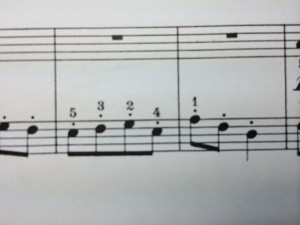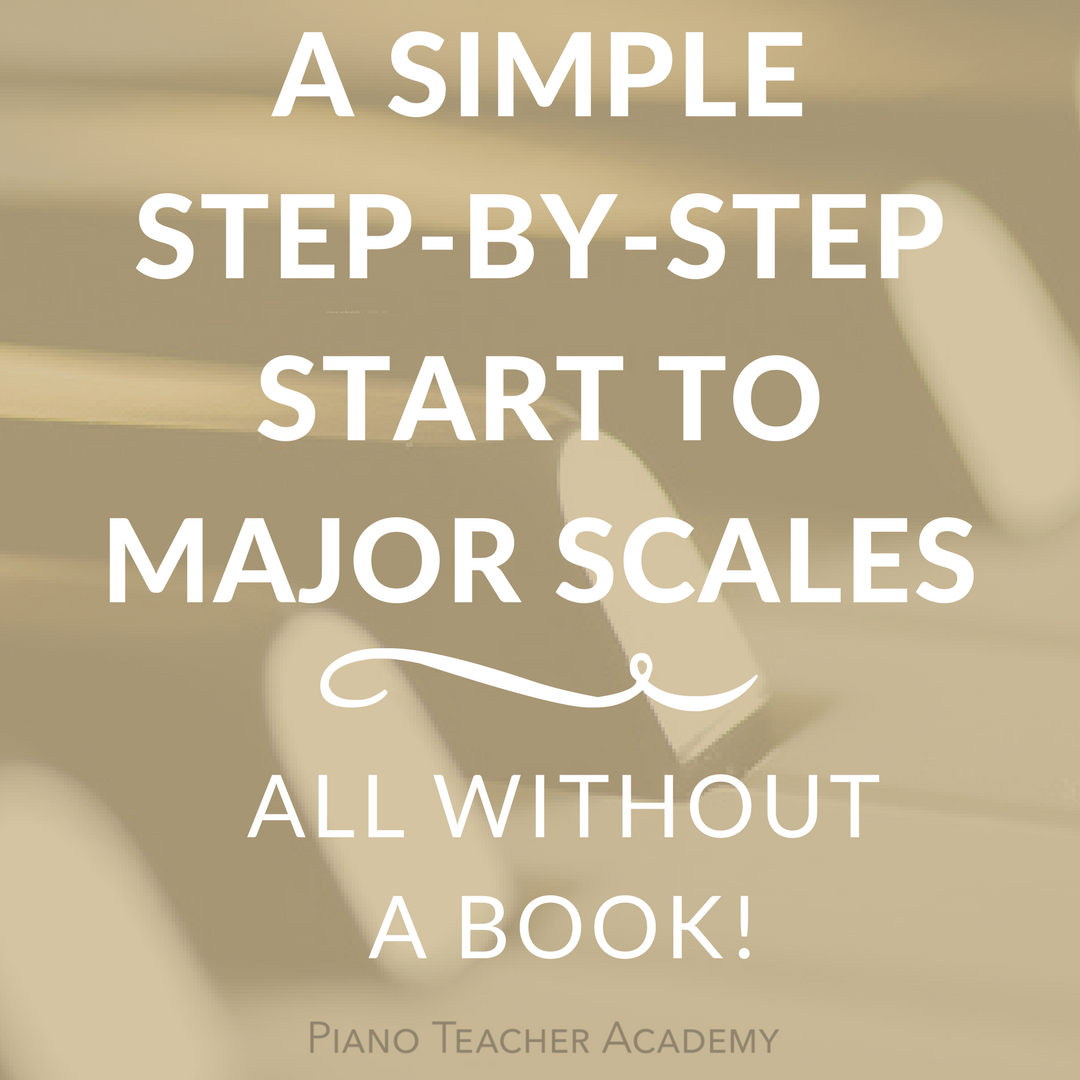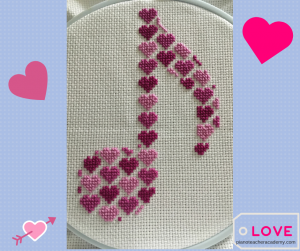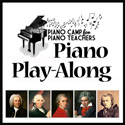Kabalevsky, Op. 39, Play-Along: Post Six (Nos. 17 – 20 Reaction)
Please don’t stress if you’re a little behind on the Play Along (like this post) or if you’ve just discovered the Play Along. You can start now with the first Reaction post here and catch up a little each day. You have plenty of time to read through the pieces and post comments until July 31. The prize drawing for those who have read and posted at least 3 comments (either here or on the Facebook group page) will be held on August 1.
If you missed last week’s reaction post (the 5th one) on Nos. 13 thru 16, you can read it HERE.
Quick-scan thoughts for Nos. 17 thru 20:
- The pieces are now solidly at the early intermediate level and the hands are really moving about. LH is more technically demanding than seen before.
- More pieces with 16th notes, and there are a multitude of rhythmic patterns present.
- More complexity in the HT playing with opposing rhythms and articulations.
- Kabalevsky seems to favor 2/4 time at this stage and earlier as well. It promotes a more lively character in the faster pieces.
- In these four selections, the hands are approx. one octave apart most of the time.
Thoughts while playing….
No. 17 – Folk Dance (I see “Dance” indicated in a different edition)
When presented with the option of this piece, or No. 18, 19, or 20, one of my summer students selected this one in an instant. She said she liked how the hands matched each other (we’ve seen Kabalevsky’s parallel movement of the hands in several pieces before).
My student is at the intermediate level and she learned this piece hands together in one week! (medium tempo) but….I must admit that she was highly motivated. She said she really enjoyed how the hands jumped around and imitated each other, first the RH in m. 5 and then the LH in m. 21. This student was familiar with D major (the scale, chords, and basic cadences) so the keysignature wasn’t a major stumbling block.
She and I worked on using forearm staccato similar to what is demonstrated here:
The fingering for each hand is mostly sequential, except for mm. 3-4 of the LH: I asked her to use this fingering every time it appeared. She went along with it. It does avoid the weaker 4th finger on a black key and sets the hand firmly into the D Major 5-finger position for the notes that follow.
I asked her to use this fingering every time it appeared. She went along with it. It does avoid the weaker 4th finger on a black key and sets the hand firmly into the D Major 5-finger position for the notes that follow.
When played with attention to dynamics, this piece is quite charming and playful. My student said it was easy to memorize, too. An added plus!
No. 18 – Galop (I’ve seen “Gallop” and “Hopping” indicated in different editions; a reader mentioned she has seen “Ride, Ride”)
This is a frisky little piece, yet challenging due to the opposing articulations between the hands and those tough leaps in the RH in mm. 5 – 7 (I suppose this is why the piece was called “Hopping” in other editions) . I told the student in the video below to block the intervals in each leap, name them (4th, 6th, 8ve), and then look for that distance when playing them. He said it helped to memorize this area so he could look down for the leaps. Good idea.
Before learning this piece, he was already proficient in playing 16th notes, 2-note slurs, and crisp staccatos.
No. 19 – Prelude
Today I explained the term “prelude” to a student and asked her what this particular piece might be “introducing”. She watched the score while I played and her response was: “It sounds like it’s introducing a scary story or a scary movie.” She said that the staccatos made it sound “sneaky.”
I listened to a few performances of this piece on YouTube and heard several taking tempos much faster than Moderato. The perpetual eighth-note motion creates enough flow in the piece on its own. Many of the performances completely omitted Kabalevsky’s dynamics or didn’t do much to exaggerate them. Without dynamics this piece falls flat and sounds more like a mere exercise on scales and broken chords. Not very interesting.
I’m not keen on Mr. Kabalevsky’s LH fingering in m. 14 (if it is his own). I much prefer the 3rd finger on the B-flat than 5th finger. It fits the 5-finger hand position and matches the RH fingering on that same beat. Your thoughts?
Three things I like about this piece:
- It’s unusual meandering quality over a wide range.
- The clever imitation Kabalevsky introduces at m. 14 to the end.
- The dramatic diminuendo at the end with an abrupt close to the constant motion.
No. 20 – Clowns (also seen as “The Clown” in some editions)
For decades this catchy piece has been a hands-down student favorite with its quirky clowning effects of major vs. minor and the “funny” notes, as my student described them (see RH of mm. 6 & 7). This piece never loses its appeal nor sounds dated. Once learned it feels as good under the fingers as it sounds.
When asked why he liked it, my student said: “I like how the melody goes back and forth between major and minor; it sounds fast & lively, and also cheerful, and I like how it sounds funny.”
This piece relies on the steadiness of the LH with its bouncing eighths and wrist rotation to keep things loose and light. It’s easy for students to overplay the LH by holding the wrist too low as seen in this video.
After he adjusted his hand position, the entire LH became much lighter, especially the thumb as it played on its side tip rather than on a good portion of the finger.
In this next video you’ll see the student play two RH fingering choices for the ending. The first was included in the my student’s mixed-composer anthology and the second from the authorized Schirmer edition. My student promptly informed me that he much preferred the Schirmer fingering (the latter).
NOTE: I see that some editions include a poco rit. in m. 23. Schirmer’s Authorized doesn’t indicate one. I’ve taught it both ways and prefer not to take the rit. How about you?
How long have you known of “Clowns?” Though I never played “Clowns” as a young student, I heard it at least once in every studio recital during my pre-college years. It’s definitely a toe-tapper!
Which piece(s) caught your attention this week?
We’re almost to the finish line. Four more pieces to review next Monday and then we’re ready for the prize drawing! Get your comments in…..I look forward to your reactions on these. Should we do a short Play-Along for August? I have some ideas that might help us prepare for fall teaching. Let me know your thoughts.
Enjoy!










I am absolutely in love with these pieces. The more I play them the more I love them! I definitely think we should do another one in August. This is so much fun!
Hi Jeanne, and others who view this:
Which pieces sound appealing to you for the August Play-Along?
1. BLOCH: Enfantines (10 Early Int. to Int. pieces) —written for his daughters and each reflects a child’s experience. Should be better known.
2. GRETCHANINOV: Children’s Book, Op. 98 (15 LE -I pieces) — his best-known set of teaching pieces. Lovely character pieces.
3. KHACHATURIAN: Adventures of Ivan (8 Int. to LI pieces) —- Listeners of all ages can appreciate these!
4. AN ETUDE A DAY KEEPS YOUR FINGERS OK: A Play-Along with Czerny’s One Hundred Progressive Studies, Op. 139 (LE thru Int). The goal would be to read through all 100 in 30 days (they’re quite short) in order to get in good technical shape for the fall. I’ll post my reactions weekly you can chime in with your favorite finger-builders.
So which of the above sounds good to you? Other ideas instead? I’d like to get a vote by July 25 so folks can have time to obtain music. Thanks!
I like the idea of Czerny’s etudes.
Thanks for your input, Mandy. Keep the votes coming everyone. I’ll make a final decision in a day or two.